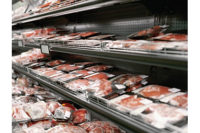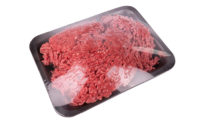Every meat packaging format has its place, at least for today. By tomorrow the market landscape may have shifted once again, reordering the field. This isn’t news; it’s the nature of a responsive and vibrant retail marketplace. Lifestyles, economics, and trends persistently conspire to skew the most critical consumer question, “What’s for dinner tonight?” There’s never a shortage of suitors vying to provide the next answer.
The flood of schemes to configure meat that better appeals to shoppers’ appetites, circumstances, and wallets rarely brings radical packaging changes. People don’t buy packaging, they buy products, and it makes good sense to adapt new ones to existing packaging processes, if possible. However, the effect of these market entries, not so much individually but on the whole, is to redefine the application sweet spots for the major packaging formats. Modified atmosphere packaging (MAP) and overwrap are two good examples.
Overwrap is still the king of the full-service meat case. “More and more shoppers want to know about the source and history of the products they buy,” says an industry source. “It’s almost like a relationship.” They’re partial to retail settings where they can get something cut specifically for them and their needs. Overwrap helps reinforce that sensation of personalization or at least communicates local packaging. “It’s retailer to retailer, but I think it has its niche. There’s a reason the business is still here, and it has to be greater choice and options at the point of sale, or you’d just abandon it.”
Functional full-service meat cases aren’t overwrap’s only stage. For retailers that don’t or can’t staff trained meat cutters, that packaged-in-store feeling can still be shared through a modest case-ready program. Overwrapped foam trays in a gas-flushed mother bag furnish extended distribution life until the bag is opened. However, afterwards, retailers must live with the short case life of the individual packages. It’s the bitter with sweet.
On the other hand, shifting market forces are steering modified atmosphere packaging away from commodity applications, according to the source. “For those consumers doing their everyday bulk type of shopping for the family, the flex and vacuum skin packs are dominant.” He points out that the longer shelf life, better cube utilization for logistics, and lower packaging costs from these rollstock formats prompt some hard economic questions when it comes to basic staple protein applications. “Are you able to sell a pound of ground beef that’s MAP pack for 25 to 30 percent more packaging cost than you would on the flexible side? I don’t think so, because people aren’t buying the package, they’re buying the protein based on cost per pound. I have lower pack cost. I’m parking more margin. I have less shrink, so the numbers start to push me in that direction if I’m the retailer.”
It begs the question for MAP: Where’s my sweet spot? “It’s value-added.” That’s where the money is. Consumers want meal choices — the more the better. For a significant number, good food that requires less personal energy or time to prepare and delivers satisfaction is appealing. “If I’m a small processor I can differentiate by doing the value-add like ready-meals or these prepared dinners. I don’t have the same capital investment as I do with a rollstock machine. It’s easier to buy a three-station tray sealer. Maybe this has happened because MAP was losing share to rollstock or maybe because it’s generally the best presentation for those applications. I’m not sure. The numbers have to justify.”
One thing is for sure. Consumers’ motivations and notions drive food development faster and more intensely today than ever before. Nimbleness and flexibility are vital. Changing format emphasis can come rapidly. Nothing is static. Nothing is permanent. More and more these packaging conversations are becoming snapshots in time.





Report Abusive Comment